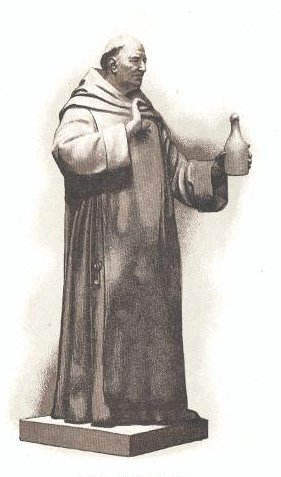Dom Pérignon
Dom Pérignon is a brand of vintage Champagne produced by the Champagne house Moët & Chandon. It is named after Dom Pierre Pérignon, a Benedictine monk who was an important quality pioneer for Champagne wine but who, contrary to popular myths, did not discover the champagne method for making sparkling wines. Dom Pérignon is always a vintage champagne, meaning that it is not made in weak years, and all grapes used to make the wine were harvested in the same year.
History[edit | edit source]
Dom Pierre Pérignon (1638–1715) was appointed cellar master at the Benedictine Abbey in Hautvillers in 1668. His work in the Champagne region has garnered him a legendary status, though much of the mythology surrounding his role in the development of sparkling wines is now considered to be exaggerated. The brand Dom Pérignon itself was created in 1921, with the first vintage produced in 1921 and released for sale in 1936. The brand was named after the monk to honor his contributions to the development of the production methods for Champagne.
Production[edit | edit source]
Dom Pérignon is produced by Moët & Chandon, which belongs to the luxury goods company LVMH. The production of Dom Pérignon adheres strictly to the vintage champagne rules, which means that it is only made in exceptional years from the best grapes in the region. The blend of grape varieties used in Dom Pérignon typically includes Chardonnay and Pinot Noir, reflecting the traditional Champagne blend. The exact composition of the blend varies from one vintage to another, depending on the year's specific conditions and the winemaker's vision for the final product.
Tasting Notes[edit | edit source]
Dom Pérignon is known for its complexity, depth, and aging potential. A typical tasting note might describe the champagne as having aromas of almond and cocoa, smooth textures, and a finish that offers hints of the earthy character that is typical of the Champagne region. The aging process, which involves a minimum of seven years in the bottle before release, contributes significantly to the development of these complex flavors and textures.
Vintages[edit | edit source]
Not every year sees the release of a Dom Pérignon vintage. The decision to release a vintage is made after careful consideration of the year's grape quality and the resulting wine. Some of the most celebrated vintages include 1961, 1976, 1990, and 2002. Each vintage of Dom Pérignon has its unique character, reflecting the specific conditions of its year of production.
Cultural Impact[edit | edit source]
Dom Pérignon has become synonymous with luxury and exclusivity. It is often associated with celebrations, significant events, and high-end dining. The brand has been featured in numerous films, songs, and cultural references, cementing its status as a symbol of sophistication and celebration.
See Also[edit | edit source]
Search WikiMD
Ad.Tired of being Overweight? Try W8MD's physician weight loss program.
Semaglutide (Ozempic / Wegovy and Tirzepatide (Mounjaro / Zepbound) available.
Advertise on WikiMD
|
WikiMD's Wellness Encyclopedia |
| Let Food Be Thy Medicine Medicine Thy Food - Hippocrates |
Translate this page: - East Asian
中文,
日本,
한국어,
South Asian
हिन्दी,
தமிழ்,
తెలుగు,
Urdu,
ಕನ್ನಡ,
Southeast Asian
Indonesian,
Vietnamese,
Thai,
မြန်မာဘာသာ,
বাংলা
European
español,
Deutsch,
français,
Greek,
português do Brasil,
polski,
română,
русский,
Nederlands,
norsk,
svenska,
suomi,
Italian
Middle Eastern & African
عربى,
Turkish,
Persian,
Hebrew,
Afrikaans,
isiZulu,
Kiswahili,
Other
Bulgarian,
Hungarian,
Czech,
Swedish,
മലയാളം,
मराठी,
ਪੰਜਾਬੀ,
ગુજરાતી,
Portuguese,
Ukrainian
Medical Disclaimer: WikiMD is not a substitute for professional medical advice. The information on WikiMD is provided as an information resource only, may be incorrect, outdated or misleading, and is not to be used or relied on for any diagnostic or treatment purposes. Please consult your health care provider before making any healthcare decisions or for guidance about a specific medical condition. WikiMD expressly disclaims responsibility, and shall have no liability, for any damages, loss, injury, or liability whatsoever suffered as a result of your reliance on the information contained in this site. By visiting this site you agree to the foregoing terms and conditions, which may from time to time be changed or supplemented by WikiMD. If you do not agree to the foregoing terms and conditions, you should not enter or use this site. See full disclaimer.
Credits:Most images are courtesy of Wikimedia commons, and templates, categories Wikipedia, licensed under CC BY SA or similar.
Contributors: Prab R. Tumpati, MD

